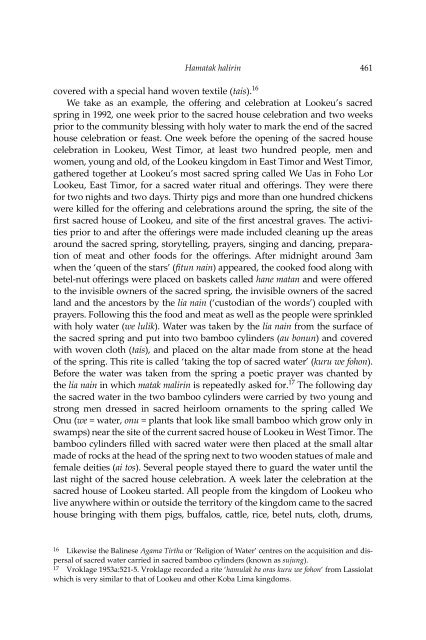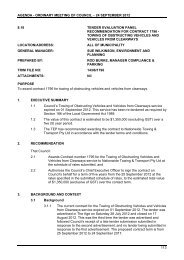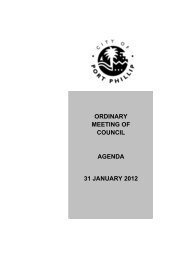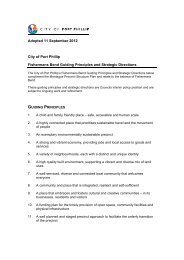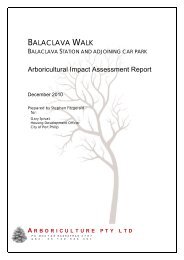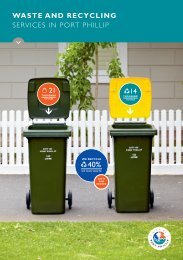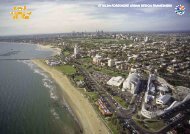Create successful ePaper yourself
Turn your PDF publications into a flip-book with our unique Google optimized e-Paper software.
Hamatak halirin 461<br />
covered with a special h<strong>and</strong> woven textile (tais). 16<br />
We take as an example, the <strong>of</strong>fering <strong>and</strong> celebration at Lookeu’s sacred<br />
spring in 1992, one week prior to the sacred house celebration <strong>and</strong> two weeks<br />
prior to the community blessing with holy water to mark the end <strong>of</strong> the sacred<br />
house celebration or feast. One week before the opening <strong>of</strong> the sacred house<br />
celebration in Lookeu, West Timor, at least two hundred people, men <strong>and</strong><br />
women, young <strong>and</strong> old, <strong>of</strong> the Lookeu kingdom in East Timor <strong>and</strong> West Timor,<br />
gathered together at Lookeu’s most sacred spring called We Uas in Foho Lor<br />
Lookeu, East Timor, for a sacred water ritual <strong>and</strong> <strong>of</strong>ferings. They were there<br />
for two nights <strong>and</strong> two days. Thirty pigs <strong>and</strong> more than one hundred chickens<br />
were killed for the <strong>of</strong>fering <strong>and</strong> celebrations around the spring, the site <strong>of</strong> the<br />
first sacred house <strong>of</strong> Lookeu, <strong>and</strong> site <strong>of</strong> the first ancestral graves. The activities<br />
prior to <strong>and</strong> after the <strong>of</strong>ferings were made included cleaning up the areas<br />
around the sacred spring, storytelling, prayers, singing <strong>and</strong> dancing, preparation<br />
<strong>of</strong> meat <strong>and</strong> other foods for the <strong>of</strong>ferings. After midnight around 3am<br />
when the ‘queen <strong>of</strong> the stars’ (fitun nain) appeared, the cooked food along with<br />
betel-nut <strong>of</strong>ferings were placed on baskets called hane matan <strong>and</strong> were <strong>of</strong>fered<br />
to the invisible owners <strong>of</strong> the sacred spring, the invisible owners <strong>of</strong> the sacred<br />
l<strong>and</strong> <strong>and</strong> the ancestors by the lia nain (‘custodian <strong>of</strong> the words’) coupled with<br />
prayers. Following this the food <strong>and</strong> meat as well as the people were sprinkled<br />
with holy water (we lulik). Water was taken by the lia nain from the surface <strong>of</strong><br />
the sacred spring <strong>and</strong> put into two bamboo cylinders (au bonun) <strong>and</strong> covered<br />
with woven cloth (tais), <strong>and</strong> placed on the altar made from stone at the head<br />
<strong>of</strong> the spring. This rite is called ‘taking the top <strong>of</strong> sacred water’ (kuru we fohon).<br />
Before the water was taken from the spring a poetic prayer was chanted by<br />
the lia nain in which matak malirin is repeatedly asked for. 17 The following day<br />
the sacred water in the two bamboo cylinders were carried by two young <strong>and</strong><br />
strong men dressed in sacred heirloom ornaments to the spring called We<br />
Onu (we = water, onu = plants that look like small bamboo which grow only in<br />
swamps) near the site <strong>of</strong> the current sacred house <strong>of</strong> Lookeu in West Timor. The<br />
bamboo cylinders filled with sacred water were then placed at the small altar<br />
made <strong>of</strong> rocks at the head <strong>of</strong> the spring next to two wooden statues <strong>of</strong> male <strong>and</strong><br />
female deities (ai tos). Several people stayed there to guard the water until the<br />
last night <strong>of</strong> the sacred house celebration. A week later the celebration at the<br />
sacred house <strong>of</strong> Lookeu started. All people from the kingdom <strong>of</strong> Lookeu who<br />
live anywhere within or outside the territory <strong>of</strong> the kingdom came to the sacred<br />
house bringing with them pigs, buffalos, cattle, rice, betel nuts, cloth, drums,<br />
16 Likewise the Balinese Agama Tirtha or ‘Religion <strong>of</strong> Water’ centres on the acquisition <strong>and</strong> dispersal<br />
<strong>of</strong> sacred water carried in sacred bamboo cylinders (known as sujung).<br />
17 Vroklage 1953a:521-5. Vroklage recorded a rite ‘hamulak ba oras kuru we fohon’ from Lassiolat<br />
which is very similar to that <strong>of</strong> Lookeu <strong>and</strong> other Koba Lima kingdoms.


